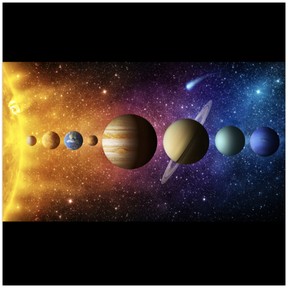
Planets and other objects in space
I can name the planets and identify their physical features.



8,000 schools use Gynzy
92,000 teachers use Gynzy
1,600,000 students use Gynzy
General
In this lesson, students will learn about the eight planets in our solar system: Mercury, Venus, Earth, Mars, Jupiter, Saturn, Uranus, and Neptune. They will use the mnemonic, "My Very Energetic Mother Just Served Us Nachos" to remember the order of the planets. They will conceptualize how these planets can look so small but actually be very large. They will also learn how gravity affects planets. They will learn about how days and years work on each planet.
Standards
NGSS: 5-ESS1-1
Learning objective
Students will be able to name the planets and identify their physical features.
Introduction
Students will think about Earth and how it is different from other planets in the solar system.
Instruction
They will "stargaze" and drag stars to the galaxy to see what could be in our solar system. They will learn a mnemonic to remember the planets in order from the sun: "My Very Energetic Mother Just Served Us Nachos." They will discuss how big the planets are and talk about an effect that can make things that are very large appear small. They will put their thumbs up to a larger object, such as a clock, and slowly walk backward. They will discuss that at a certain point, their thumbs covered the clock and that the size of the clock didn't change, but their distance from it did. They will transfer this knowledge to the solar system.
Students will discuss the amount of time it takes for a planet to make a rotation on their axis (a day) versus the amount of time it takes to make one trip around the sun (a year). They can also see how their age changes on other planets in our solar system. Students will discuss how gravity affects their weights on different planets.
The first four planets, or the inner planets, are Mercury, Venus, Earth, and Mars. Students will read about some facts about each planet, including their size, number of rings, number of moons, and the length of a day/year. They will then answer some questions about what they learned about the first four planets.
They will also talk about the asteroid belt, a region between the orbits of Mars and Jupiter. The next four planets, or the outer planets, are much larger. They are Jupiter, Saturn, Uranus, and Neptune. Students will read facts about these planets as well. They will then review the mnemonic they learned at the beginning of the lesson.
Quiz
Have your students answer these multiple-choice questions about the planets!
Closing
Students will research a planet and write some lyrics about it to the tune of "Twinkle, Twinkle Little Star."
The online teaching platform for interactive whiteboards and displays in schools
Save time building lessons
Manage the classroom more efficiently
Increase student engagement
Discover more!
About Gynzy
Gynzy is an online teaching platform for interactive whiteboards and displays in schools.
With a focus on elementary education, Gynzy’s Whiteboard, digital tools, and activities make it easy for teachers to save time building lessons, increase student engagement, and make classroom management more efficient.



